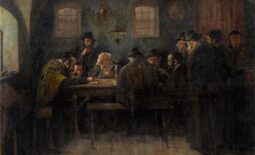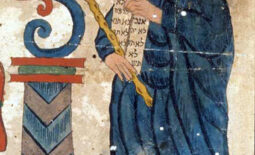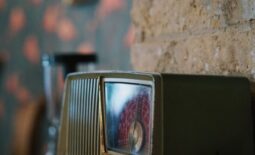The problem with Jews in fiction
Note: jLab is for blog posts about creative, fun, or interesting Jewish or congregation-related topics. To submit a post, you must be a member of our congregation, and the topic must be Jew-ish, related to our congregation or the wider Jewish community. If you have something to share, please submit it here.
By Douglas W. Jones
Most portrayals of Jews in fiction are weak. It doesn’t matter if they’re on television, the stage or in print, Jewish characters seem to fall into a few broad classes. Token Jews show up for ethnic diversity. Sometimes, nothing about them seems Jewish other than the mention that they are. Sometimes, they drip Yiddishisms and Jewish steriotypes, but their purpose is to be Jewish, not to convey anything about Jews other than the fact that they’re different.
Disaffected Jews are frequently the product of disaffected Jewish writers following the classic advice: Write about what you know. They teach their readers everything about Judaism that their authors are escaping, but leave us with hardly any understanding of how Judaism can possibly have managed to survive for thousands of years.
Add to this an additional problem. Fictional portrayals of Jews are mostly set in modern times, except in biblical fiction. It is as if fiction was trying to teach us that there were lots of Jews in Roman times, and then there were pogroms and the Holocaust. What happened between? Very few works of fiction have anything but token Jews in that long 2000 year gap.
Here are three books that really try to fill this gap:
A Journey to the End of the Millenium, by A. B. Yehoshua. Hebrew Edition, 1998, English translation by Nicholas de Lange, 1999.
Set in the year 999, this book might be described as the chronicle of a road trip. A Jewish merchant and his Arab business partner, both from North Africa, find themselves in trouble. The caravan that was to meet them to haul their wares north to Paris from Catelonia doesn’t meet their ship, and they eventually learn that their trading partner has died. Their entire fortune is tied up in the merchandise, so they decide to sail up the Atlantic coast and then up the Seine to Paris. From there, they make their way east to Worms before returning to Paris and the end of the story.
The story takes place when the divergence between Ashkenazic and Sephardic culture was still young. The setting is just before Rabbenau Gershom promulgated his ban on polygamy, and the travelers from North Africa find polygamy quite natural. The Jewish community of Paris was already ancient, and the travelers encounter both Christian and Jewish communities along the way.
The book has a foreboding tone. Significant parts of the Christian community are waiting for the Second Coming, scheduled for the year 1000, and the author is very aware of the huge impact the First Crusade would have on the Jewish world a mere century in the future.
My biggest complaint has to do with literary style. The sentences are very long and the paragraphs even longer. If you can wade through that, though, it is a very rewarding tale.
The Last Kabbalist of Lisbon, by Richard Zimler, 2000.
Set in Lisbon not long after the expulsion of Jews from Spain in 1492, the book focuses on a printer and illuminator. Printing was still a very young art, and the art of the sofer still mattered in Jewish book production.
There are three communities in Lisbon of the era, Old Christians, the majority, New Christians (conversaros, former Jews), and Jews. The town is in the twin grips of drought and epidemic. Among Christians, the initial response is that this must be God’s punishment for their sins, and parades of penetential flagilants are a fixture. As Passover approaches, though, they become aware of a new sin, the fact that they are tolerating Jews in their midst.
At the start of the story, New Christians are relatively safe, and there are apparently solid friendships across boundaries within the community. As the story progresses, those friendships fray, and by the end, nobody is safe.
It’s as bloody as any story from the Holocaust, replete with mass murder, hiding places, secret meetings and hairbreadth escapes, but set 500 years earlier. Despite the blood, I found the story to be gripping and ultimately an uplifiting tale of survival. The book includes a glossary, useful because the book not only pivots on common Jewish practices, but also on Kaballah.
The Book of Spendor, by Francis Sherwood, 2002.
This book is set in Prague in 1601. You have probably heard of some of the historical figures who play a part in this novel, Tycho Brahe and John Dee really were in Prague at the time of the Holy Roman Emperor Rudolph II and the Maharal.
The book is a romance, set in violent times. It adds a wonderful new dimension to the story of the Golem, while at the same time putting that story in its broader historical context. The names Kepler and John Dee may be familiar as astronomers and mathematicians, but it is easy to forget that they lived in an era when astronomy, astrology and alchemy were close cousins. People remember the Maharal as the great rabbi who is reputed to have made the Golem, but it is easy to forget that the Prague of his time was a cosmopolitan imperial capital.
Of the three books discussed here, I found the Book of Splendor to be the most fun to read. There were surprises around every corner, and a delightful ending.
These books are not examples of authors “writing what they know.” It takes extraordinary amounts of research to put together convincing historical drama and make past times come alive. You cannot rely on knowledge of modern Judaism to provide more than a partial framework for Jewish life of 500 years ago. Significant parts of our prayerbooks were organized later. We made changes after the Crusades and again after the Chmielnicki uprisings, and while the Mourner’s Kaddish existed in the year 1000, it was not yet called that or linked to mourning rituals.
So, take advantage of the hard work these authors have done and take the time to read these novels. The authors have created vibrant places and populated them with 3-dimensional Jewish characters.




